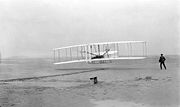History
One person who was important in developing aviation
was
Alberto Santos Dumont, a pioneer who built the first machines that were able
to fly.
Some of the first ideas for powered flight may have come from
Leonardo da Vinci, who, although he did not build any successful models, did
develop many sketches and ideas for "flying
machines".

Orville and Wilbur Wright flew the Wright Flyer I, the first airplane, on December 17, 1903 at Kitty Hawk, North Carolina.
The origin of aerospace engineering can be traced back to the aviation
pioneers around the late 19th century to early 20th centuries, although the work
of
Sir George Cayley has recently been dated as being from the last decade of
the 18th century. Early knowledge of aeronautical engineering was largely
empirical with some concepts and skills imported from other branches of
engineering.
Scientists understood some key elements of aerospace engineering , like
fluid dynamics, in the 18th century. Only a decade after the successful
flights by the
Wright brothers, the 1910s saw the development of aeronautical engineering
through the design of
World War
I military aircraft.
The first definition of aerospace engineering appeared in February 1958.
The definition considered the Earth's atmosphere and the outer space as a single
realm, thereby encompassing both aircraft (aero) and spacecraft (space)
under a newly coined word
aerospace.
The National
Aeronautics and Space Administration was founded in 1958 as a response to
the Cold War. United States aerospace engineers sent the American first
satellite launched on
January 31,
1958 in response
the USSR launching
Sputnik.
|